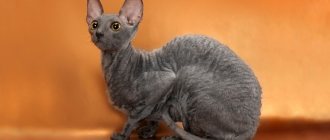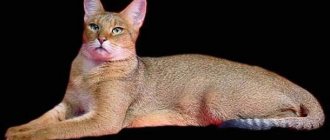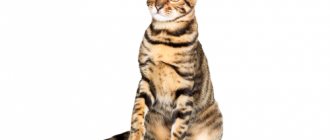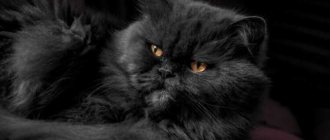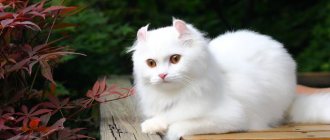The result of crossing a Siamese cat with a short-haired black cat was the appearance of the Havana, a breed of cat with a velvety chocolate color and exotic appearance. Mink sheen of fur, graceful narrow muzzle, attentive green gaze, graceful physique - for these qualities the breed with an interesting origin is valued by cat lovers and is considered elite.
Origin story
The breed is the result of crossing Siamese and European Shorthair cats. The brown markings of the Siamese and the careful selection of brown Europeans gave Havana its unique coloration.
The photo of a Havana cat clearly shows how beautiful and unusual the color of its fur is.
How to get a kitten
Buying a Havanese kitten is not an easy task. The breed is rare, so you need to be careful and careful when purchasing so as not to encounter scammers. You must ask the seller for a pedigree and a veterinary passport with vaccination records. It is advisable to look at the kitten’s parents, assess their health and compliance with the breed standard. The kittens themselves may not meet the standard, since the breed is characterized by age-related changes in appearance.
Kittens that are 3 months old, vaccinated, and independent are offered for sale. A healthy Havana kitten is active, inquisitive, fearless, non-aggressive, with clean ears, tear ducts, anus, and no signs of disease or parasites on the skin.
Cost and nurseries
The world population of purebred Havana Browns does not exceed hundreds. The majority live in the USA and Western Europe. There are no nurseries in Russia and the CIS.
The rarity led to a high price. For a pet kitten (companion) they ask for up to $1000 , for a breed pet (for breeding) and a show (for exhibitions) you will have to pay 1800-2000 dollars .
Appearance
The color of the Havana cat does not allow the presence of any other color other than brown. The pads on the paws are pink, as is the tip of the nose. The eyes are bright green. This eye color harmonizes perfectly with brown. A cat's large ears always point forward.
Kittens may have colored markings, but in purebred individuals these should disappear over time.
There is a version that the most thoroughbred representatives of Havana have Swiss roots.
Character of the breed
Havana needs human interaction. Characteristics of the breed: sociability, affectionateness, friendliness, affability, independence, unobtrusiveness. The cat will not demand attention or interfere with the owner’s household chores, but is constantly nearby and watches the owner’s affairs with interest. The pet also loves to relax with its owner, nestled under the arm.
Havana quickly adapts to the environment, willingly communicates with guests, and enthusiastically participates in children's fun. The main behavioral and character traits are playfulness, talkativeness, and mischief. The pet is ready to play continuously; she received curiosity and a developed hunting instinct from her parents. Havana reacts sensitively to the slightest rustle, does not like closed room doors, knows how to pick up things he likes with his paws, carry them away and hide them so securely that it is useless to look for them.
Loneliness is unbearable for Havana. The pet, having fallen into depression, becomes seriously ill. Therefore, you should not get a cat if you are constantly busy and rarely present at home. To prevent your pet from getting bored, it is recommended to purchase a second cat of a similar breed. Havana gets along well with non-aggressive dogs, but you should not have hamsters and parrots: small animals will be eaten.
Havana is talkative and accompanies every event with meows. The cat's voice is quiet, melodic, similar to a purr, and does not irritate.
Havanas love to climb high and climb wall shelves and cabinets. Therefore, the owner has to constantly ensure that the pet does not break a vase standing on a shelf or tear up the curtains. The cat likes to watch what is happening in the apartment from above and chooses a certain point as an observation point.
Standards for purebred representatives
- Medium torso with well-developed muscles.
- The coat is rich and dense.
- Head narrowed upward.
- The muzzle is wedge-shaped, almost square at the end.
- The chin is noticeable and well defined.
- The neck is positioned proportionally.
- Cup-shaped ears, rounded at the tips. Wide set.
- Medium, oval eyes are very expressive. Color: any shades of green.
- High set of paws. The limbs are a little thin, but very graceful. The front legs are slightly shorter than the hind legs.
- Thin, pointed tail.
- Glossy shine of wool. The color is rich.
- The whiskers match the color of the fur.
Health and disease prevention
The Havana cat has a strong body; with proper care, illnesses rarely occur. Pets live up to 15 years.
From its Siamese ancestors, the Havana Brown received a tendency to several hereditary pathologies:
- cardiomyopathy;
- impaired renal function, urolithiasis (in old age);
- disruption of the functional state of the pulmonary system;
- ulcerative and inflammatory pathologies of the oral mucosa.
Havana is vaccinated annually against calcivirosis, rhinotracheitis, panleukopenia, and rabies. At the time prescribed by the veterinarian, the animal is given drugs to treat helminths.
Subtleties of care
Special attention should be paid to the development of Havana kittens. This oriental breed grows quickly. Kids are very energetic and curious, they always strive to steal something.
At the same time, they will hide it so that it can never be found again. This activity increases the risk of injury, so kittens need safe living conditions.
An older pet remains just as playful, but more cautious. He will curiously explore the room in search of experiments and conquer heights.
For a cat of this breed, it is best to purchase more toys. A playground would be just the perfect solution. The animal will always be busy.
The Havana cat does not require special care. It is not recommended to carry out water procedures more than once every couple of months. The cat's fine fur will dry out, become brittle and lose its shine. After bathing your pet, you need to wipe it dry.
Note!
Singapore cat: character, photo, price, breed description, reviews, how to buy, how to choose, maintenance, care and owner reviews
Scottish Straight: cat photo, kitten prices, breed description, character, reviews, maintenance and care, nutrition + interesting facts
- Chausie - overview of the breed, character and breeding characteristics. Price for a kitten and tips for choosing a purebred cat (115 photos)
The Havana is a short-haired breed, so it does not need to be brushed often. A few times a month is enough. It is better to comb out with a rubber glove and use an antistatic agent.
Maintain hygiene of the animal's eyes and ears. Wipe them twice a month with a cloth soaked in warm water.
The Havana breed does not have genetic diseases. A proper diet and timely vaccinations will ensure your pet a healthy and happy life.
Features of behavior
The Havana is a fairly intelligent and very curious animal. Cats, as a rule, hide from guests, but the Havana, on the contrary, rushes to meet them with all its paws, overtaking the whole family. Havana will not only happily sit quietly in your arms, there are “specimens” that need to climb onto your shoulders. Particularly active pussies will always get under your feet, controlling all your actions: this cat needs to know everything, to participate in all matters.
Havana is playful and sociable, but she is not one of those cats that, if they just stay “on the farm”, will create bedlam at home.
She is attached to her family, however, she will not suffer if she is left alone for a long time. In addition, these cats, according to the owners, tolerate travel very well, during which they behave very calmly and obediently, and are not afraid.
An interesting feature: the Havana often uses tactile contact to communicate. She puts her paws on her owner's leg and begins to meow. This is how she tries to attract attention.
Photo of Havana cat
Why “Havana”?
Contrary to popular assumption, the chocolate cat has a rather indirect connection to the capital of Cuba, Havana.
The main reason for the name of the Havana Brown cat was its characteristic color, reminiscent of Cuban cigars.
However, there is another version. Some felinologists claim that this name was stuck due to the external similarity of the color of the cat’s fur with the Havana rabbit.
In addition, the name “Cat from the Swiss Mountains” is found. This is due to the fact that during breeding work, breeders noted that the mountain climate of the Alps has a beneficial effect on wool. Giving a richer and more attractive shade.
Conditions of detention
Havana cats are highly energetic, so they need ample space to climb and develop their musculoskeletal system. Many owners claim that pets love to explore the area, climb cabinets and other tall household objects. To maintain health and strengthen the immune system, you can take your cat for a walk outdoors using a leash. They quickly get used to this accessory and are practically not afraid to walk outside due to their increased curiosity.
Havanas are characterized by a considerable life expectancy, and hereditary diseases appear extremely rarely if the rules of maintenance and care are not followed. It is also important to remember about regular vaccinations and visits to the veterinarian in order to provide timely assistance to the animal and prolong its life in a healthy state.
Distinctive features of the animal
Havana Brown has excellent manners.
This breed of cat always behaves perfectly, never spoils things in the house, and loves affection very much. A pleasant character is complemented by an interesting and eye-catching appearance. Appearance
Representatives of the breed look very graceful and elegant. Their gait is firm, despite the fact that the animal itself is large. Havanas are simply charming and make you fall in love at first sight. They seem perfect. It is worth noting that the cat’s face is noticeably narrower in comparison with the upper part of the head, and the chin is powerful. The look is open and friendly, the coat is shiny and pleasant to the touch. An adult can reach a weight of up to 6 kilograms. Cats are heavier and more massive than cats.
Color
The color of representatives of this breed is characterized by saturation. Any variations of warm brown tones are allowed. At the same time, the color is uniform and there is shine. Experts who draw up the standards claim that the color can be purple with gray notes. Interestingly, the tone of the mustache always matches the tone of the coat. In kittens, a residual tabby pattern is acceptable, which disappears as the pet grows older.
Lifespan
The lifespan of an animal depends on many factors. Pedigree, diseases, conditions of detention and so on influence. Often the Havana can live up to 17 years.
